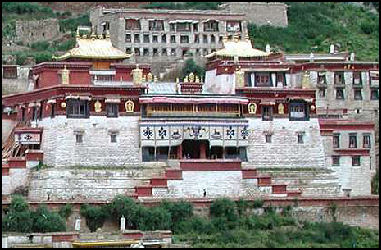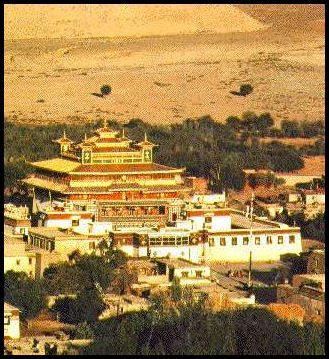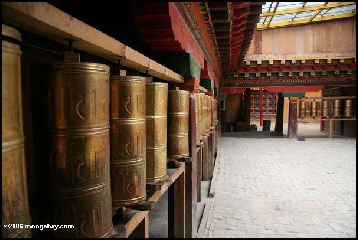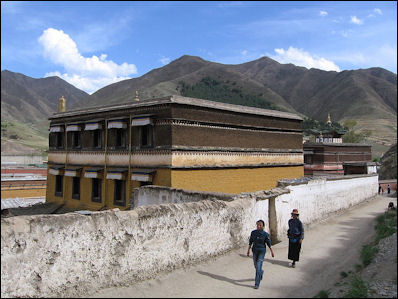TIBETAN BUDDHIST MONASTERIES

Ganden MonasteryTibetan monasteries, also known as lamaseries, have traditionally been centers of learning and quiet reflection as well as places where monks lived. Found as far north as Mongolia and Russia, they have also traditionally run temples, schools and other facilities and owned large chunks of land which they leased out to farmers. Monasteries usually sponsor ceremonies to bless villages. The ceremonies are day-long sessions of chanting and horn blowing.
There are currently about 1,700 monasteries in Tibet, up from 978 in 1987. Many of the monasteries are huge. The College of Esoteric Teaching in Labrang serves up meals for its monks in a kitchen with two woks, each nine feet across. Huge assembly halls, sometimes are decorated with stuffed yaks, goats and bears with stretched smiling faces, glass eyes and prayer flags pinned to them.
Many Tibetan monasteries have similar characteristics. Many are built in high locations above villages and resemble fortresses. Most had or still have walls that were used to protect the monastery and its treasures from bandits, invaders and even rival monk armies. Many have meditation areas, holy sites, walls of mani stones, and a kora, or pilgrimage route around the monastery.
Inside the walls is a central courtyard, where ceremonies are held and festivals are staged. It usually features a flag pole known as a "darchen" and is surrounded by a main assembly or prayer hall, known as a "dukhang," with side protector chapels, subsidiary chapels, monk quarters, a library, eating areas and a kitchen. Large monasteries have colleges, halls of residence, and an interior kora.
Monasteries of various sects of Tibetan Buddhism were traditionally the centers of educational training in all the basic arts, crafts, and professions, including medicine. Lay people provide physical support to the monasteries as well as relying on the monks to organise the rituals. Well-off monasteries receive many donations giving the monks more time to study and pray. Some monasteries have become dependent on the generosity of tourists to survive.
See Separate Articles: TIBETAN BUDDHISM factsanddetails.com; TIBETAN BUDDHIST MONKS factsanddetails.com; TIBETAN BUDDHIST LAMAS factsanddetails.com; TIBETAN ARCHITECTURE: TEMPLES, PALACES, STUPAS factsanddetails.com; TIBETAN BUDDHIST PILGRIMS factsanddetails.com; DALAI
Websites and Resources Monks and Lamas: Monk Life travelchinaguide.com ; Research on Tibetan Monks case.edu/affil/tibet ; New York Times article on monks studying science nytimes.com ; Monasteries and Pilgrims: Monastery Preservation asianart.com ; Wikipedia list Wikipedia ; Book: “Path to Buddha: A Tibetan Pilgrimage” by Steve McCurry (Phaidon Press, 2003) Mt. Kailash Wikipedia Wikipedia Sacred Sites Sacred Sites Summit Post Summit Post
RECOMMENDED BOOKS: “Labrang Monastery: A Tibetan Buddhist Community on the Inner Asian Borderlands, 1709-1958" by Paul Kocot Nietupski Amazon.com; “Sera Monastery” by José Cabezón and Penpa Dorjee Amazon.com; “The Sound of Two Hands Clapping: The Education of a Tibetan Buddhist Monk” by Georges B. J. Dreyfus Amazon.com; “From a Mountain In Tibet: A Monk’s Journey” by Yeshe Losal Rinpoche Amazon.com; “The Life of a Tibetan Monk” by Geshe Rabten Amazon.com; :The Autobiography of a Tibetan Monk” by Palden Gyatso Amazon.com; “Himalayan Hermitess: The Life of a Tibetan Buddhist Nun” by Kurtis R. Schaeffer Amazon.com; Tibetan Buddhism: “Essential Tibetan Buddhism” by Robert A. F. Thurman Amazon.com; “Initiations and Initiates in Tibet” by Alexandra David-Neel Amazon.com; “The Secret Oral Teachings in Tibetan Buddhist Sects” by Alexandra David-Neel, Lama Yongden Amazon.com; Introduction to Tibetan Buddhism by John Powers Amazon.com; “The World of Tibetan Buddhism: An Overview of Its Philosophy and Practice” by His Holiness the Dalai Lama, Geshe Thupten Jinpa Amazon.com; “Tibetan Buddhism: With its Mystic Cults, Symbolism and Mythology, and in Its Relation to Indian Buddhism” by L Austine Waddell Amazon.com; “The Jewel Tree of Tibet: The Enlightenment of Tibetan Buddhism” by Robert Thurman and Sounds True Amazon.com; “A Concise Introduction to Tibetan Buddhism” by John Powers Amazon.com; “The Preliminary Practices of Tibetan Buddhism” by Geshe Rapten Amazon.com; “Teachings and Practice of Tibetan Tantra” Amazon.com; “Tantra in Practice” by David Gordon White Amazon.com
Inside Tibetan Buddhist Monasteries
The main prayer hall contains rows of low seats and tables, often covered with monk clothing and religious objects. On the main altar are statues of the Buddhist triad (the Present, Past and Future Buddhas) and perhaps important lamas associated with the monastery. On a smaller altar are butter lamps, seven bowls of water, and offerings.
Monasteries often contain thousands of frescoes and statues of Buddha, Boddhavistas (Buddhist saints) and Buddhist gods such as Avalokitesvara, the eleven-headed God of Mercy. Many of the frescoes depict episode from Buddha's life. They have traditionally been used to educate the illiterate masses the same way frescoes and paintings with scenes from the lives of Christ, Mary and the saints have been used in old Christian churches to educate their illiterate followers.
Inside a monastery the rooms are filled with smoke from rancid-smelling yak butter lamps and incense burners with cypress leaves. Monks beat on drums while chanting in high-pitched voices.
At the entrance to most buildings are murals of the Four Guardian Kings, sometimes with a Wheel of Life or mandala mural. Inner rooms are often flanked by protector gods such as the red Tamdrin (Hayagriva) and the blue Chana Dorje (Vajrapani). The proctor chapels are often dark and gloomy. They contain images of skulls, corpses and beasts. Sometimes the images of protector gods themselves are covered by cloth because they are regarded as too terrible to look at.
The three most important monasteries in Tibet — the "pillars of the Tibetan state" — are Ganden, Drepung and Sera, all of which are located outside of Lhasa. All three were badly damaged during the Cultural Revolution, and they are currently being restored. Drepung used to be the largest monastery in the world.
Samye Monastery: Tibet's First Buddhist Monastery

Samye
Samye Monastery (in Dranang, 30 kilometers west of Tsetang) is the oldest monastery in Tibet. Situated in the Yarlung Valley, it is said to have been built where the Tantric yogi Padmasambhava built an enormous mandala to exorcize evil forces from the area. At the center of the main temple is a large golden Buddha with four corners.
Although the Samye trove has an extensive collection of artifacts, its murals are prestigious throughout Tibet. Samye has many valuable murals. They include murals telling of Padmasambhava's life (ground and second floors of Utse), the history of Samye (south cloister on the second floor of Utse) and other murals reflecting the local folklore. The Samye murals are actually an encyclopedia of Tibetan culture and religion.
Samye means “Unimaginable” in Tibetan. It was said that when King Tritsong Detsen asked for suggestions about the construction of the monastery, Padmasambhava, exerting his magical powers, showed the king an image of a monastery in his palm. That is the origin of the name. Padmasambhava chose the construction site while the design was done by Santarakshita. After the construction was completed, Buddhism became the official religion in Tibet. Learned monks from inland China and India were invited to Tibet to translate Buddhist sutras into Tibetan. Trisong Detsen selected seven nobles to be the first monks in Tibet. Thus, Samye became the first formal monastery to establish triratna (refer to the Buddha), the Dharma and the Sangha, or Buddhist priesthood. [Source: chinaculture.org, Chinadaily.com.cn, Ministry of Culture, P.R.China]
See Separate Article NEAR LHASA factsanddetails.com
Ganden Monastery: Source of the Gelug Sect and Dalai Lamas
Ganden Ganden (60 kilometers east of Lhasa in Dagze county) is one of the most magnificent monasteries in the world and is one of the Three Great Monasteries of the Lhasa area, along with Sera Monastery and Drepung Monastery. Not as many people visit it as the other two because it is farther away from Lhasa and harder to get to.
Reached by a road with 17 hairpin turns and built in the side of rocky mountain, Ganden was founded in 1409 and became one of Tibet's most influential monasteries, producing the dynasty of Dalai Lamas, who ruled Tibet from 1642 to 1950. Ganden Monastery was destroyed by explosives in the 1960s. Its 3,300 monks were scattered, killed or imprisoned. In late 1980s monks and local volunteers began rebuilding the monastery.
The main buildings include the Coqen Hall, the Chamber of Tsong Khapa, and the Yangbajian Zhacang (colleges for studying the sutras). The three-story Coqen Hall is the monastery's main hall, large enough to hold a gathering of 3,000 lamas, who use the hall for sutra recitation. The main hall was not completed until 1417, two years before Tsong Khapa died, but after having announced his disciple, Gyeltsab Je, as the new leader of the Gelug Sect or Ganden Chiba.
See Separate Article NEAR LHASA factsanddetails.com
Drepung Monastery
Drepung Monastery (seven kilometers east of Lhasa) was once the largest monastery in the world. Built in the 15th century, it housed 12,000 monks at its height. During the Cultural Revolution the monastery was all but deserted. By 1988 about 500 monks had returned. In 2000, there were around 800 monks down from 10,000 before the Chinese invasion. Today, there are maybe 1,000. Drepung was a focal point of the protest that launched the 2008 riots in Lhasa. We had to go through a metal detector to enter the monastery as we did at other important sites in Lhasa.
Almost as impressive as Potala Palace, Drepung covers 250,000 square meters. is built next to a gully and steep slope of Gebeiwoze Mountain and consists of a multitude of whitewashed building scattered over a ravine. Frescoes decorate the walls and statues line many of the halls. The library houses a large collection of sutras and rare books. The kitchen has room-size pots used to feed the 6,000 monks who once lived at the monastery Drepung Monastery is called Zhaibung in Chinese and is known as Duimi or Gyimi monastery, which means "an auspicious land," in Tibetan.
In Tibetan Drepung literally means "Rice Heap". From a distance away the off-white monastery looks like a heap of rice, hence it's name. Sitting on Mount Gambo Utse in a western suburb of Lhasa, Drepung Monastery is part of a famous kora. The monastery was built in 1416 by Jamyang Choge Tashi Palden, one of Tsongkhapa’s main disciples, and is one of the Three Great Monasteries of Lhasa, along with Sera Monastery and Ganden Monastery. A 65-million-yuan (about US$10 million) restoration of Drepung was started in June 2009 and completed in early 2012.
See Separate Article DREPUNG AND SERA MONASTERIES: THE MAIN WORKING MONASTERIES OF LHASA factsanddetails.com
Sera Monastery
 Sera Monastery (four kilometers north of Lhasa) is one of the three largest monasteries of the Gelug Sect. It sits on the southern slope of the strangely shaped Serawoze Mountain in the northern suburbs of Lhasa, sprawled out over an area of 114,960 square meters. Sera is regarded as prestigious and important as Drepung and Ganden Monasteries, but is not as old as they are. Sera means "Wild Rose Garden" in Tibetan. It is named after the opulent wild rose woods that once grew around the monastery.
Sera Monastery (four kilometers north of Lhasa) is one of the three largest monasteries of the Gelug Sect. It sits on the southern slope of the strangely shaped Serawoze Mountain in the northern suburbs of Lhasa, sprawled out over an area of 114,960 square meters. Sera is regarded as prestigious and important as Drepung and Ganden Monasteries, but is not as old as they are. Sera means "Wild Rose Garden" in Tibetan. It is named after the opulent wild rose woods that once grew around the monastery.
Only a few hundred of the 5,000 monks that once lived here remain. These monks, who belong to the Yellow Hat sect, are famous for their martial arts and debating skills. About 2,000 devotees visit every week. Many come to get a special mark put on their head. The monastery caters to members of all three of the main Tibetan Buddhist sects.
Since ancient times, Living Buddhas and monks have taught the Buddhist doctrines in the area surrounding Sera. Dotted with willow trees, it is also home to many small monasteries and nunneries, including the Purbujor and Zhachi Holy Maid monasteries, Myiqoinre Nunnery, the Kardoreqoi mediation area, and the Balungreqoi (If you know what this is, explain. I saw only one entry in my website search and it didn't show anything) to the east and south; Barku, Gungbasa, Pobengang, Zhaxiqoilin, and Qoisang monasteries as well as the Garil Nunnery to the west; and Zhukangreqoi and Seraqoiding monasteries to the rear.
See Separate Article DREPUNG AND SERA MONASTERIES: THE MAIN WORKING MONASTERIES OF LHASA factsanddetails.com
Tashilhunpo Monastery
Tashilunba Monetary (in Shigatse) contains the largest Gelug (Yellow Hat) Sect Temple in Tibet and the home of the Panchen Lama. Situated on the slopes of Neseri Mountain, it contains a large Palace Hall and a large Scripture Hall. The latter contains the 80-foot-high Maitreya, the largest copper Buddha in the world. Records show that this Buddha was cast from 6,700 ounces of gold and over 115,000 kilograms of copper. At its peak the monastery contained 4,000 monks, now it only has 600. In 1989, a giant gold reliquary chorten was constructed for the body of the 10th Panchen Lama.
Also called the Heap of Glory, Tashilhunpo Monastery was founded in 1447 by the First Dalai Lama. According to historical documents, the Tashilhungpo Monastery was built under the supervision of the first Dalai Lama Genden Zhuba, a disciple of Master Tsongkhapa (Zongkapa), founder of the Gelug Sect (Yellow Sect). When the fourth Panchen Lobsan Qoigyi, titled by the Qing (1644-1911) emperor, became the abbot, it was expanded to a large scale. Since then, the monastery has become the residence of the Panchen Lama.
Tashilhungpo means auspicious Sumeru. It is one of the Big Six Monasteries of the Gelug (Yellow Hat) sect of Buddhism in Tibet and is one of the "Four Famous Monasteries" of the Gelug Sect of Tibetan Buddhism (the other three being Sera, Drepung, and Ganden in the Lhasa area). Tashilhungpo occupies 150,000 square meters. Facing south, the complex is built symmetrically against the Nyima Mountain. Its wall, over 3,000 meters long and built according to the topography of the mountain, surrounds 57 buildings, with more than 3,600 rooms.
See Separate Article SHIGATSE AREA factsanddetails.com
Labrang Monastery

Labrang Monastery (near Xiahe) is the largest and most important Tibetan Buddhist monastery outside of Tibet and the largest working monastery in Tibet and China. Built in 1709 by the living Buddha Jianuyang and situated 7,000 feet above level, this Yellow Hat religious complex is home to 2,000 monks, twice the number Beijing allows it to have, and embraces 35 temples, six academic institutes, several large temples, living Buddha residences, lama and monk quarters, 10,000 volumes of Tibetan classics and countless lesser scriptures and historic relics.
Labrang Tashikyil Monastery is located in Xiahe County, Gannan Tibetan Autonomous Prefecture It is one of the six major monasteries of the Gelukpa tradition of Tibetan Buddhism and is the most important one in Amdo. Built in 1710, it is headed by the Jamyang-zhaypa. It has 6 dratsang (colleges), and houses over sixty thousand religious texts and other works of literature as well as other cultural artifacts.
Labrang is the largest still functioning lamasery. It attracts pilgrims from all over China and is a kind of mother temple to smaller temples in Gansu and Qinghai provinces. Pilgrims walk on a two-mile path around various temple buildings, rotating the 1,174 prayer wheels along the way and kissing walls. Try to visit the monastery in the morning before the Chinese tour groups arrive.
See Separate Article GANSU PROVINCE: LANZHOU AND NEARBY BUDDHIST AND TIBETAN SITES factsanddetails.com
Demolishing Tibetan Monasteries and Turning Others into Communist Propaganda Centers?
In 2016, China demolished buildings at Larung Gar, one of the largest Buddhist academies in Tibet. UPI reported: “Free Tibet shared photos and video showing wood and stone scattered about from parts of the Larung Gar monastery which were demolished as part of an effort to reduce population in the area. According to a post on their website, Free Tibet said a Chinese work team arrived at the monastery alongside officials, police and members of the armed forces dressed in plain clothes at around 8 a.m. on Wednesday. "They brought bulldozers and other demolition equipment. Upon arriving, they began to pull down residences belonging to the monastery," the post stated. [Source: Daniel Uria, UPI, July 23, 2016]
“Chinese authorities have placed an order stating that Larung Gar's population must be reduced from 10,000 to no more than 3,500 nuns and 1,500 monks by October. The BBC reports that authorities have not made a formal comment on the demolition, Free Tibet Director Eleanor Byrne-Rosengren argued that overcrowding is not the real issue. "The demolition at Larung Gar is clearly nothing to do with overcrowding — it is just another tactic in China's attempt to subvert the influence of Buddhism in Tibet," she said.
“A student at Larung Gar also questioned the practice in an online post. "If its only option to solve the over population is destroying the houses then why is the same policy not implemented in the Chinese cities and towns where population is overcrowded?" he wrote. "Where is the equality, rule by law, public welfare, religious freedom and equal rights of all nationalities (they used to say) if you crush down the houses of innocent religious practitioners who are living simple lives."
In January 2015, the top Chinese appointed official in Tibet said Buddhist temples and monasteries in Tibet must become Communist Party propaganda centers, where monks and nuns learn to "revere" science and appreciate the party's love. Reuters reported: Writing in the influential fortnightly party magazine Qiushi, Tibet's Communist Party boss Chen Quanguo said the more than 1,700 temples and monasteries and 46,000 monks and nuns had to be seen by the government as "friends". "Let the monks and nuns in the temples and monasteries have a personal feeling of the party and government's care and warmth; let them feel the party's benevolence, listen to the party's words and follow the party's path," Chen wrote in Qiushi, which means "seeking truth". [Source: Reuters, January 3, 2015]
“He called for temples and monasteries in the region to be outfitted with radios and televisions, as well as newspapers and reading rooms. "Monks and nuns should not have to go out of their temples or monasteries to understand the party and government's policies and social progress, or Tibet's peace, stability and good fortune, so as to be guided to follow a path of revering scientific culture." Chen has struck a similar line before, writing in late 2013 that Chinese officials in Tibet must build an "impenetrable defense" against separatism and befriend monks and nuns, who are generally revered by the devoutly Buddhist Tibetans.
Image Sources: Mongabay, Wason Collection, Kalachakranet.org
Text Sources: New York Times, Washington Post, Los Angeles Times, Times of London, National Geographic, The New Yorker, Time, Newsweek, Reuters, AP, Lonely Planet Guides, Compton’s Encyclopedia and various books and other publications.
Last updated September 2022
